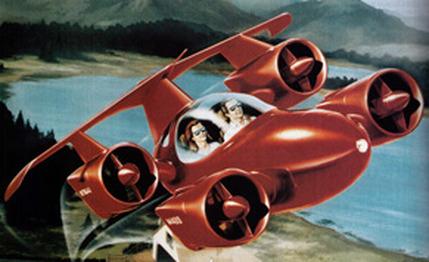
 Specialty File
Specialty File
Actually, I found it rather easy to make money in real estate," explains Paul Moller. "But making money in flying cars? That's hard." That hasn't kept him from trying for a very long time. "I've been working probably eight hours a day, including weekends, since 1963 on this project."
And Moller's Skycar prototypes haven't spent a lot of time in the air over those 37 years, but they've generated loads of press. Journals ranging from the National Enquirer to the New York Times have reported on Moller's seemingly imminent reinvention of personal transportation. An illustration of his M400 "volantor" (from the French volant, which means "flying") showed up on the cover of Popular Mechanics in 1991, and this year the prototype has been on the covers of both Popular Science and Forbes FYI. But just because we can't yet telephone for a computer-piloted air taxi to whisk us door-to-door along a well-defined "skyway" doesn't mean it won't happen. Eventually.
In an industrial park in Davis, California, that Moller himself built, the Moller International company works methodically, if not feverishly, toward the first flight of the fiberglass four-seat M400 prototype. The 34,500-square-foot facility is littered with artifacts that have accumulated over nearly four decades of chasing a dream. Inside, there is a small plywood wind tunnel, a Honda Civic converted into a gasoline/electric hybrid incorporating one of the tiny 530cc single-rotor rotary engines destined to power the prototype Skycar some day, press clippings both recent and ancient tacked on bulletin boards, and scale models and prototypes dating back to the Kennedy Administration.
The M400 isn't really a car, although it should be "roadable," according to Moller, and capable of replacing cars on round trips of more than 100 miles (which, he says, is where 80 percent of the mileage on America's cars are racked up). Moller calls it a "powered lift aircraft" that relies on thrust generated from eight Moller-built Rotapower Wankel-type rotary engines to rise vertically and on the aerodynamic lift of its body shape to keep it aloft in horizontal flight. Instead of a wing's movable surfaces, the M400 will theoretically control its flight by varying engine power and directing thrust with venetian-blind-like carbon-fiber vanes. If the PC-based flight control computers fail (there are three redundant systems), a parachute will open to bring the machine down gently. That parachute system, like a lot of things on the M400, is still more a concept than a reality. If it works as Moller says it will (a big if), the M400 should take off and land vertically in a space smaller than a driveway. It should cruise at about 350 mph, have a range of 900 miles, and fly completely under computer control.
"To be a success, it clearly has to be an air-taxi-like vehicle," says Moller, who grew up on a chicken farm in British Columbia and moved to Davis to establish the aeronautical engineering program at the University of California campus there in the early '60s. The key to his whole concept is that his flying car is not piloted -- a computer does that for its "passenger." His flying car must "arrive robotically and take you along as a passenger, not as a pilot. If you have discretionary power to drive this thing, I'm not going to get in there with you. You really have to be integrated into a control network. You have to believe in the computers without a potential of failure, that there are multiple engines, that there are no critical components, and no chance of failure." A lot to believe in. That such a perfect control network doesn't exist hardly fazes Moller, who holds both master's and doctoral degrees in mechanical and aeronautical engineering from McGill University in Montreal. He also looks surprisingly young, but otherwise pretty much how one imagines an eccentric engineer should.
On the surface, Moller's quixotic dream of a car that flies is preposterous. "In the beginning, it starts as a personal quest," says Moller. "Build a vehicle you can fly or drive. Over a period of time, of course, as you grow older, you have to rationalize your life a little more. Quite frankly, it took me 35 years to do that." But during that time he did manage to make a small fortune in real-estate development, to start and later sell an exhaust-system company called SuperTrapp. Plus he's done work on millions of dollars of government contracts for hybrid cars and flying camera platforms, among other things. He's also harvested cash from his almond farm. Done all that, plus married and raised two kids. All that money, and much more from investors, has been plowed back into the Skycar project.